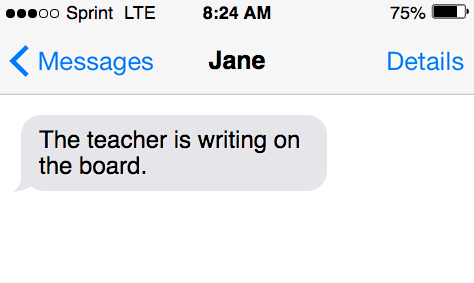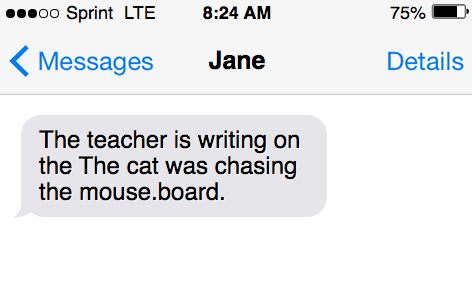What does it mean to write in the active voice? What about writing in the passive voice? What’s the difference between the two?
Keep reading the rest of this article to find the answer, and learn the difference between writing in the active and passive voice.
Active voice vs. passive voice: what’s the difference?
The general rule of thumb is to write in the active voice and not the passive voice.
Why is that the general advice when it comes to writing? And what does it even mean to write in the active voice?
When we discuss the ‘voice’ in a sentence or writing, this refers to the subject (of the sentence) that is doing or receiving the action or verb (of the same sentence).
To be more specific, the voice of a sentence describes who or what is doing the verb (or action) of the sentence; or receiving the action.

English has multiple tenses (which refer to the time at which the action was done, and helps us differentiate between whether the action referred to was in the past, present or future tense).
The active voice describes writing in the present, or actively describes the subject in the sentence doing the sentence action or verb. This means that when writing in the active voice, there is an active subject, or the subject is doing the action.
The passive voice, on the other hand, describes the subject as receiving the action in a sentence, and so they are the passive subject in the sense that they passively receive the action.
| Form | Definition |
| Active voice | Active voice is a grammatical voice common in many of the world’s languages. It is the unmarked voice for clauses featuring a transitive verb in nominative–accusative languages, including English and most other Indo-European languages. (Wikipedia) |
| Passive voice | A passive voice construction is a grammatical voice construction that is found in many languages. In a clause with passive voice, the grammatical subject expresses the theme or patient of the main verb – that is, the person or thing that undergoes the action or has its state changed. (Wikipedia) |
QUICK TRICK!
A quick trick to remember the difference between writing in the passive and active voice is the following:
Active voice = action = someone doing an action.
Passive voice = when the subject receives an action, instead of being described as doing the action itself.
How to tell when writing uses the active or passive voice
To tell whether writing uses the active or passive voice, look at the subject sentence, and ask: is the subject performing or doing the action, or are they the recipient of the action?
Let’s look at a couple examples of sentences written in the active voice:
- The teacher is writing on the board.
- The cat was chasing the mouse.
- I am eating a pizza.
- He is painting the house.
- She is swimming in the pool.
- They are flying a kite.
- John plays the piano.
- Deborah read the book.
- Bobby dug the ditch.
See how in each example sentence, the subject actively does the action described in the sentence. Take a look:
- The teacher (subject) is writing (verb) on the board.
- The cat (subject) was chasing (verb) the mouse.
- I (subject) am eating (verb) the pizza.
Writing in the passive voice is the inverse or opposite of writing using the active voice. Look at the example sentences from above being modified to the passive voice.
Active voice verb list (compared to passive)
Refer to the table below to see more active voice verbs.
| Tense | Active verb list | Passive verb list |
| Simple present | write/writes | is/am/are written |
| Present continuous | is/am/are writing | is/are/am being written |
| Present perfect | has/have written | has/have been written |
| Simple past | wrote | was/were written |
| Past continuous | was/were writing | was/were being written |
| Past perfect | had written | had been written |
| Simple future | will/shall write | will/shall be written |
| Future continuous | will/shall be writing | — |
| Future perfect | will/shall have written | will/shall have been written |
Examples of sentences in the passive voice
Take a look at the following sentences written in the passive voice:
- The piano is played by the girl.
- The book was read by Deborah.
- Jimmy was called by me last night.
- The ditch was dug by Bobby.
- The board was written on by the teacher.
- The mouse was being chased by the cat.
- The kite is being flown by them.
- The house is being painted by him.
See how in each example above, the subject of the sentence receives the act, rather than doing the act described. This is what makes the writing here passive: the fact that the sentence subject receives rather than does the verb or action described in the sentence.
See the sentence, “The piano is played by the girl.” The piano is the subject in the sentence, and here it receives the action of the sentence, i.e., ‘played’, since it was played on by the girl. Therefore, it’s written in the passive voice, and not the active voice.

Similarly, “The book was read by Deborah.” The book is the subject (the ‘who’ or ‘what’ that the sentence is about,) and again, see how the subject receives the action: The book was read by Deborah.
The book received the action of being read (so to speak,) and therefore is passive in being acted upon, rather than being active itself.
To look at one more, “The ditch was dug by Bobby.” The ditch here is the subject, since the subject is receiving the action (to be dug by) the sentence is in the passive voice.
To see how writing in the passive can be more confusing than using the active, look at these sentences side-by-side:
- The cat scares the mouse.
- The mouse is scared by the cat.
The first sentence is written in the active voice: The cat scares the mouse.
The cat is the subject, and this cat is in the act of scaring the mouse, (which is the action occurring in the sentence.)
The subject therefore is doing the action in the sentence, and so this uses the active voice.
Reading the second sentence, “The mouse is scared by the cat.” Here, the mouse is the subject, but the mouse is not performing an action. Rather, the mouse receives the action from the cat, and is a passive subject.

Therefore, when the subject does the action described, it’s active; whereas when the subject is passive, it receives the action in the sentence.
Why active voice is recommended in writing
Generally speaking, the common advice given to students and people learning to write is to write in the active voice. Writing in the active voice tends to be more concise, and makes it easier for readers to follow and comprehend what’s written.
This is because the active voice clearly describes what the subject is doing while they are doing it.
Conversely, passive refers to what is being done to the subject, and so the way in which the information is being presented to readers is more awkward and less natural to digest.

Another reason for this is because when we speak in conversation, typically we use the active voice. For example, if I were to say “I’m buying some food,” this is a straightforward sentence with a subject (first person pronoun, I,) verb (buying) and object (food).
It’s clear what is going on in the sentence, and who is doing what. If we were to change this to be written in the passive voice, “The food is being bought by me,” or “The food was bought by me.”
This is written in the passive voice, and describes the same thing, but it’s much more confusing to follow and the way it reads is awkward compared to the same sentence written using the active voice.
When should writing be in the passive voice?
There are some instances in writing where it is appropriate to use the passive voice rather than the active voice. Fiction writers, for example, will sometimes write in the passive voice.
That said, not all sentences can be changed to the passive voice. Sentences that include intransitive verbs, for example, cannot be modified to be in the passive voice.
Intransitive verbs do not require a direct object to express a complete thought or sentence. Transitive verbs, on the other hand, require direct objects in the sentence to be a complete clause.
Examples of sentences with intransitive verbs:
- Her car died suddenly last week.
- Someone was coughing loudly.
In the above sentences, these are written in the active and do not include a direct object, so they cannot be changed into the passive voice.
In passive sentences, the object, person or thing acted on comes first, then it is followed by the actor or do-er of the action. In passive sentences, the actor (person doing the verb of the sentence) can be omitted entirely. Take a look:
- The uncertainty principle was formulated in 1927.
This is important to note: in situations where we might not know who the actor of a sentence is, or the person doing the action, it can be appropriate to use the passive voice so we can omit the actor in the sentence fully.
Similarly, in writing if the intention is to be vague about the actor in the sentence, writing in passive is effective in these cases.
Other times, to emphasize or draw attention to the thing or object being acted upon, write in the passive voice. For example:
- The email was written by me.
Here, the attention is given to the thing or object that was acted upon: the email was written by me.
To write this in the active voice: I wrote the email.
See the difference? The subject (email,) in the first sentence includes an object pronoun, i.e., my at the end. This is passive.
Once we revise the sentence to be in the active voice, we use the subject pronoun instead, I, and the sentence object (or thing that is acted upon) comes at the end, the email.
More formal writing or academic writing, such as in science, will sometimes use the passive voice to be more objective or separated from the information written.
Exercises
Quiz time! Which of the following sentences are active and passive? Find the answers at the bottom of this page.
- Emma writes a letter.
- A letter was written by Emma.
- Emma will write a letter.
- A letter will be written by Emma.

Active voice rules
Refer to the tables below for the active voice rules (in comparison with passive voice rules).
Future perfect tense rules
| Active voice | Passive voice |
| Subject + will+ have +v3+ object. | Object+ will+ have+ been +V3+ by + subject |
| Subject + will+ have +not+v3+ object. | Object + will+ have +not+been+v3+ subject |
| Will+ Subject+have+v3+ object | Will + object+have+been+v3+by +subject |
Future simple tense rules
| Active voice | Passive Voice (using auxiliary verb will+ be) |
| Subject + will+ v1+ object | Object+ will+ be +V3+ by + subject |
| Subject +will + not+ V1+object | Object + will+ not +be+V3+ by Subject |
| Will+ Subject + V1+ object | Will + Object+ be +v3+ by+ subject |
Past perfect tense rules
| Active voice | Passive Voice (using auxiliary verb had +been) |
| Subject + had + v3+ object. | Object+ had+been +V3+ by + subject |
| Subject +had+ not+v3+ object | Object + had+ not +been+V3+ by Subject |
| Had+ Subject + V3+ object | Had + Object+ been+v3+ by+ subject |
Past continuous tense rules
| Active voice | Passive Voice (using auxiliary verb was/were + being) |
| Subject + was/were + v1+ing+ object. | Object+ was/were +being+V3+ by + subject |
| Subject +was/were+ not+v1+ing + object | Object + was/were+ not +being+V3+ by Subject |
| Was/were+ Subject + V1+ing + object | Was/were + Object+ being+v3+ by+ subject |
Past simple tense rules
| Active voice | Passive Voice (using auxiliary verb was/were) |
| Subject + V2+ object | Object+ was/were V3+ by + subject |
| Subject +did+ not+v1+ object | Object + was/were+ not +V3+ by Subject |
| Did+ subject+V1+ object | Was/were + Object+ V3+ by subject |
Present perfect tense rules
| Active voice | Passive Voice (using auxiliary verb has/have +been) |
| Subject + has/have+ v3+ object | Object+ has/have+ been+ V3+ by + subject |
| Subject + has/have+ not+ v3+ object | Object + has/have+ not + been+V3+ by Subject |
| Has/have+ subject+ v3 + object | Has/Have + Object+ been+V3+ by subject |
Present continuous tense rules
| Active voice | Passive Voice (using auxiliary Verb- is/am/are + being) |
| Subject + is/am/are+ v1+ ing + object | Object+ is/am/are+ being+ V3+ by + subject |
| Subject + is/am/are+ not+ v1+ ing+ object | Object + is/am/are+ not + being+V3+ by Subject |
| Is/am/are+ subject+v1+ing + object | Is/am/are + Object+ V3+ by subject |
Present simple tense rules
| Active voice | Passive Voice (using auxiliary Verb – is/am/are) |
| Subject + V1+s/es+ object | Object+ is/am/are+ V3+ by + subject |
| Subject + Do/does+ not + V1 + Object | Object + is/am/are+ not + V3+ by Subject |
| Does+ Subject+ V1+Object | Is/am/are + Object+ V3+ by subject |
Common questions
Questions about the English language.
How to change passive voice to active voice
To change active voice to passive voice, replace the verb tenses you’re using in a sentence with the active voice verbs. Once you’ve accomplished that, read the sentence once more for any grammatical mistakes.
Quiz answers
- Active
- Passive
- Active
- Passive
In Review
- The active voice describes the subject as doing the action.
- The passive voice describes the subject as receiving the action in a sentence.
- Writing in the active voice is easier to follow, and presents the information in a more logical fashion so that it is digestible for readers.
Glossary
Sources
Inside this article
Fact checked:
Content is rigorously reviewed by a team of qualified and experienced fact checkers. Fact checkers review articles for factual accuracy, relevance, and timeliness. Learn more.
Core lessons
Glossary
- Abstract Noun
- Accusative Case
- Anecdote
- Antonym
- Active Sentence
- Adverb
- Adjective
- Allegory
- Alliteration
- Adjective Clause
- Adjective Phrase
- Ampersand
- Anastrophe
- Adverbial Clause
- Appositive Phrase
- Clause
- Compound Adjective
- Complex Sentence
- Compound Words
- Compound Predicate
- Common Noun
- Comparative Adjective
- Comparative and Superlative
- Compound Noun
- Compound Subject
- Compound Sentence
- Copular Verb
- Collective Noun
- Colloquialism
- Conciseness
- Consonance
- Conditional
- Concrete Noun
- Conjunction
- Conjugation
- Conditional Sentence
- Comma Splice
- Correlative Conjunction
- Coordinating Conjunction
- Coordinate Adjective
- Cumulative Adjective
- Dative Case
- Determiner
- Declarative Sentence
- Declarative Statement
- Direct Object Pronoun
- Direct Object
- Diction
- Diphthong
- Dangling Modifier
- Demonstrative Pronoun
- Demonstrative Adjective
- Direct Characterization
- Definite Article
- Doublespeak
- False Dilemma Fallacy
- Future Perfect Progressive
- Future Simple
- Future Perfect Continuous
- Future Perfect
- First Conditional
- Irregular Adjective
- Irregular Verb
- Imperative Sentence
- Indefinite Article
- Intransitive Verb
- Introductory Phrase
- Indefinite Pronoun
- Indirect Characterization
- Interrogative Sentence
- Intensive Pronoun
- Inanimate Object
- Indefinite Tense
- Infinitive Phrase
- Interjection
- Intensifier
- Infinitive
- Indicative Mood
- Participle
- Parallelism
- Prepositional Phrase
- Past Simple Tense
- Past Continuous Tense
- Past Perfect Tense
- Past Progressive Tense
- Present Simple Tense
- Present Perfect Tense
- Personal Pronoun
- Personification
- Persuasive Writing
- Parallel Structure
- Phrasal Verb
- Predicate Adjective
- Predicate Nominative
- Phonetic Language
- Plural Noun
- Punctuation
- Punctuation Marks
- Preposition
- Preposition of Place
- Parts of Speech
- Possessive Adjective
- Possessive Determiner
- Possessive Case
- Possessive Noun
- Proper Adjective
- Proper Noun
- Present Participle
- Prefix
- Predicate



